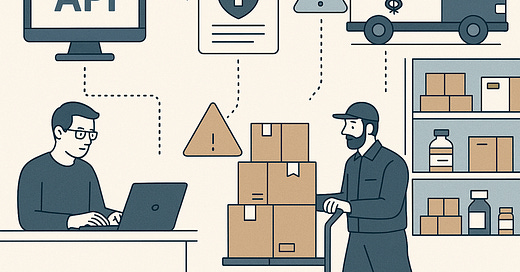Building Logistics APIs for Regulated Medical Shipments: Challenges, Solutions, and Future Prospects
APIs for Regulated Medical Logistics Evolved
In today’s digitized logistics landscape, integrating APIs to streamline courier operations has become non-negotiable—especially in the regulated domain of medical shipping. For courier services handling temperature-sensitive, legally bound shipments such as prescription drugs or natural formulations, building and maintaining robust tech infrastructure is essential. Companies offering the best medicine courier services in Calicut are increasingly adopting technology to differentiate themselves. APIs are now the backbone of secure, trackable, and regulation-compliant logistics, enabling smooth end-to-end visibility and data exchange between pharmacies, patients, and global compliance bodies.
However, building APIs for this highly specific use case is not as simple as integrating off-the-shelf logistics plugins. It involves dealing with compliance protocols, real-time environmental monitoring, dynamic routing, and audit logging—all of which require thoughtful technical architecture. This article explores the nuanced challenges in building APIs for regulated medical shipments and how tech-forward courier companies are solving them.
1. The Compliance-First Architecture Approach
Medical logistics APIs do not operate in a neutral, unrestricted environment. Every data packet sent and received must comply with legal and regulatory standards, both domestic (e.g., CDSCO guidelines in India) and international (like the FDA, HIPAA, and customs frameworks).
Key API considerations for compliance:
Authentication and Authorization: OAuth2.0 or API keys must be tightly managed to restrict access to sensitive shipment or prescription data.
Audit Logging: Every interaction—whether a label print, temperature read, or handover confirmation—must be logged for traceability.
Data Anonymization and Encryption: PII (personally identifiable information) must be encrypted in-transit and at-rest, especially in APIs used to transfer patient prescriptions or order history.
Companies building the best medicine courier services in Calicut often start with a compliance-first API design. This means compliance dictates the structure of endpoints, access control models, and data flows—reversing the typical "build first, secure later" approach.
2. Real-Time Temperature and Condition Monitoring Integration
Unlike traditional e-commerce shipments, medical products like insulin, vaccines, or ayurvedic oils must often be stored and shipped within precise environmental conditions. This introduces a major API challenge: how to integrate dynamic, real-time data from IoT sensors into a logistics tech stack.
Challenges:
Heterogeneity of Devices: Not all temperature sensors or geolocation trackers follow the same data format or update cycle.
Network Latency: Poor connectivity in transit (e.g., rural or remote legs) can lead to data gaps.
Volume and Frequency of Data: Real-time monitoring from hundreds of sensors can overwhelm API rate limits if not managed carefully.
Solutions:
Event-Driven Architecture: Instead of polling for temperature data, event-based APIs and WebSockets can push only exception-based updates (e.g., breach alerts).
Middleware Normalization: An intermediate layer to normalize sensor data from different vendors into a common format ensures consistency in the API payloads.
Edge Caching and Sync: For remote areas, edge devices temporarily store data and sync to the main system once connectivity is restored.
Such capabilities are fast becoming the standard for international and domestic medicine courier operations, particularly in tech-forward regions like Calicut where demand for scalable, transparent logistics is growing.
3. Multi-Stakeholder API Ecosystems
A regulated medicine shipment isn’t a one-vendor job. It involves pharmacies, third-party logistics (3PLs), customs agents, cold storage units, and end-customers. API architectures must support multi-tenant, role-based interactions while ensuring data isolation and proper permissions.
Technical architecture considerations include:
API Gateways with Role Routing: An API call from a pharmacist should behave differently than a call from a delivery agent.
Callback URLs and Webhooks: For shipment updates, return confirmations, or temperature excursions, APIs must support webhooks to notify different stakeholders instantly.
Tokenized Tracking: Providing secure, link-based tracking where customers can view shipment status without authentication, yet without compromising security.
With such collaborative logistics in play, companies delivering the best medicine courier services in Calicut are turning their API platforms into intelligent hubs of coordination and transparency.
4. Machine Learning and Predictive APIs for Route Optimization
Once the foundational APIs are in place, the next technical leap lies in predictive optimization. APIs can be extended to support machine learning models that forecast delays, recommend optimal shipping paths, and even predict customs clearance times.
Advanced features being adopted include:
Weather-Aware Routing APIs: Integrate weather APIs to re-route shipments that are vulnerable to environmental changes (e.g., avoiding heat zones for certain balms or medicines).
Compliance Scoring Engines: Use AI to assess documentation completeness before customs submissions.
Demand Forecast APIs: Pharmacies and hospitals can be notified of stock delivery times based on real-time route behavior and ML-based ETAs.
While still emerging, these predictive APIs are the next frontier for players offering not just the best medicine courier services in Calicut, but also the most future-ready logistics tech in the region.
Conclusion:
The future of medicine courier services is inseparable from API innovation. From compliance-first endpoints and IoT sensor integration to multi-stakeholder orchestration and AI-powered routing, every technical decision shapes the reliability, safety, and efficiency of critical medical deliveries.
Courier companies in evolving tech corridors like Calicut are no longer just delivery agents—they are becoming full-stack health logistics platforms. For developers, architects, and CTOs working in logistics tech, this means one thing: API infrastructure must evolve from transactional to intelligent.
If you are designing systems in this space, the strategic question is not “how do we deliver faster,” but “how do we embed compliance, intelligence, and flexibility directly into our APIs?” That’s the bar now set by companies leading in regulated delivery—those defining what it truly means to offer the best medicine courier services in Calicut and beyond.



